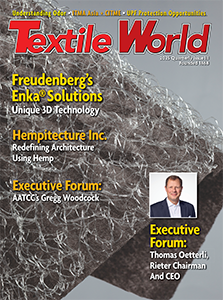 By Jürg Rupp, Executive Editor
By Jürg Rupp, Executive Editor
The first Rupp Report of this year was titled “2015 – A Busy Year.” If we take a look back one can say, indeed it was a quite busy year. As China always plays a major role in the game of the global economy, the Chinese Lunar year was also mentioned. It was, and still is, the year of the sheep. “Sheep are said to be friendly, calm and moral people,” reported The Rupp Report. “Sheep years are traditionally years without major ups and downs.” However, it wasn’t always a harmonious year. Though, some positive results were achieved.
Examples of some concerns in 2015 include the crisis and the worries about the future of Greece and the crash in oil prices. Greece succeeded, but with a lot of pain for its people. On the other hand, oil prices are still down and continue to shake the global economy. The Rupp Report thinks that this situation will not change that much in the near future.
Techtextil
One of the highlights for this year was certainly Techtextil in Frankfurt. From May 4-7, 2015, the biggest Techtextil of all time took place. The event recorded some 42,000 visitors from 116 countries. Techtextil showed with its 1,389 exhibitors an increase of 4.4 percent over the previous event. It was an event “close to the perfect exhibition” as the Rupp Report mentioned.
The most important point of Techtextil was the fact that — finally — the machinery industry has awakened. Hall 3.0 was somewhat a mini ITMA with so many companies that play a major role in the technical textiles and nonwovens segment; and all participants were more than satisfied with their participation. Peter D. Dornier said: “if you want to build new markets, you have to find the right machinery manufacturer.” Technical textiles as well as nonwovens will certainly increase their importance too in the year 2016, and Techtextil will probably bigger next time in 2017.
ITMA 2015
Then, the most important event held every four years arrived. For the first time in its history, ITMA took place in November because of the World Expo schedule. Despite rumors about the current value of an ITMA Europe, the floor space for the show was sold out. Of particular interest at ITMA was sustainability, or more precisely water and energy savings. Every supplier that showed new equipment that consumes less power, less water or produces at a faster speed was very happy with the feedback from visitors.
The recent Rupp Report, “Who Owns And Leads ITMA?,” received some feedback. The Rupp Report asked “How many exhibitions are needed for the global textile machinery industry?” To clarify the situation, questions were asked at the press conference at ITMA Europe. No answer to the questions. Then some 15 top suppliers from around the world were asked if they liked that ITMA Asia is held every two years instead of the four year rhythm of the two firsts shows? Everybody said “no.”
This report provoked some unanimous feedback from the industry.
Busy Year
Nevertheless, let’s look at 2016, which will be quite a busy year. There are many events to come, beginning with Heimtextil, Colombiatex, maybe the Inlegmash in Russia, and certainly Techtextil North America in Atlanta, as well as IDEA, the nonwovens show in Boston. If Turkey is an important market, and for many companies it is, one should go to ITM in Istanbul. There are many more important shows for the industry next year, but one focus will be ITMA Asia in Shanghai, to be held October 21-25, 2016, as well as the India ITME to be held December 3-8, 2016.
In 2016, some economic and environmental problems are desperately waiting to be solved. The World Trade Organization agreement risks to be ignored and abandoned, and the Transatlantic Trade and Investment Partnership (TTIP) is another big question mark.
Think Global, Think Sustainable
Currently, if one takes a look at modern Beijing everybody knows it is high noon for our grandchildren and the planet. But there may be some light at the end of the tunnel. At a symposium on the 13th Five-Year Plan from 2106-2020, Chinese Premier Li Keqiang mentioned the new growth concept that highlights innovation, coordinated and green development, opening up and inclusiveness. He said: “The formulation of the plan should be based on global and domestic economic conditions to strike a balance between growth and restructuring. More should be done to address industrial overcapacity, the aging population, fragile social security system, and insufficient public services.”
Structural reforms at both supply and demand ends should be continued. The government will also seek to expand effective investment, upgrade consumption and pushing new types of urbanization. “The five-year plan should focus on growth quality and efficiency to increase innovation’s contribution to economic expansion,” Li added. The symposium at the National Development and Reform Commission was attended by analysts and economists from China and abroad. What a signal! For the first time, the State Council invited foreign experts to offer advice for a five-year plan.
Not only is China a big polluter of the world — the United States and India, as well as countries with coal-burning power plants such as Germany, should not only have nice gatherings in Paris, but also do their homework.
With the outcome of ITMA in Milan, the future for the textile industry looks promising. Some suppliers already have delivery times in the second half of 2016.
Thank You All
To close this year of The Rupp Report, I’d like to thank indeed all the readers around the globe for feedback, by email or by personal meeting somewhere in this world. Also the whole staff of Textile World, Textiles Panamericanos and Textile World Asia wishes readers a happy, successful, and most of all, healthy New Year. Thank you very much indeed for all signs of appreciation in the past year. We’ll see you around, cheers.
December 15, 2015

 By Jürg Rupp, Executive Editor
By Jürg Rupp, Executive Editor


